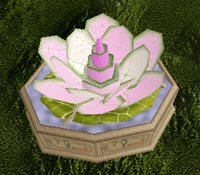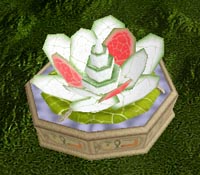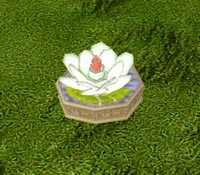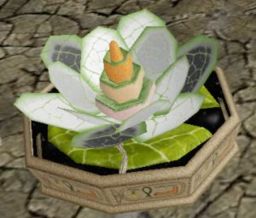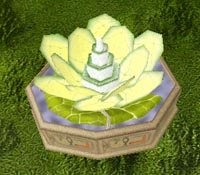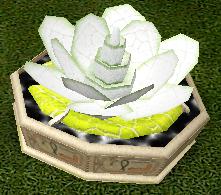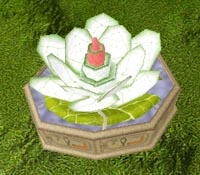The Wiki for Tale 4 is in read-only mode and is available for archival and reference purposes only. Please visit the current Tale 11 Wiki in the meantime.
If you have any issues with this Wiki, please post in #wiki-editing on Discord or contact Brad in-game.
Difference between revisions of "Sea Lilies"
| (32 intermediate revisions by 15 users not shown) | |||
| Line 1: | Line 1: | ||
| − | + | {{T3}} | |
| − | It appears in inventory as "Sea Lily Bulb:<type>". One bulb per player may be acquired for free from a University of Worship with Horticulture unlocked. | + | It appears in inventory as "Sea Lily Bulb:<type>". One bulb per player may be acquired for free from a University of Worship with [[Horticulture]] unlocked. |
| − | It may be planted anywhere, but requires 100 | + | It may be planted anywhere, but requires 100 [[Water in Jugs]] in your inventory to do so (the jugs will be emptied but retained). When planted, it will bloom into a '''Lily of the Sea''' in one hour. Once it blooms, it may be fertilized every 2 hours with 20 units of [[Flower Fertilizer]]. After 24 fertilizations, you can "Check the bulb for signs of budding" from the flower's window menu. The amount of fertilizations required to detach an extra bulb from a Lily of the Sea is strain and fertilizer dependent. |
| + | |||
| + | With [[Advanced Horticulture]] there are [[Fertilization|Advanced Fertilizers]] available to make fertilizing sea lilies faster and easier. | ||
| + | |||
| + | ==Color Regions== | ||
A Sea Lily has 7 color regions: | A Sea Lily has 7 color regions: | ||
| − | + | * 4 Petal Regions (2 Outer Petal colors, alternating, and 2 Inner Petal colors, alternating) | |
| − | + | * Outer Stamen (the uppermost center section-2 sections ) | |
| − | + | * Middle Stamen (the middle height center stamen, the lowest one easily visible) | |
| − | + | * Inner Stamen (the lowest center section, almost hidden in the petals) | |
| − | [[image:Sea_Lily_Bulb$Inner_Petals.jpg|thumb|256px|Inner Petals]] | + | |
| − | [[image:Sea_Lily_Bulb$Outer_Petals.jpg|thumb|256px|Outer Petals]] | + | {| border="1" |
| − | [[image:Sea_Lily_Bulb$Stamen.jpg|thumb|256px|Stamen]] | + | |[[image:Sea_Lily_Bulb$Inner_Petals.jpg|thumb|256px|Inner Petals]] |
| + | |[[image:Sea_Lily_Bulb$Outer_Petals.jpg|thumb|256px|Outer Petals]] | ||
| + | |[[image:Sea_Lily_Bulb$Stamen.jpg|thumb|256px|Stamen]] | ||
| + | |- | ||
| + | |} | ||
When research calls for petal colors, it will request something like "75%" of a color, which means 3 of the four petal regions that color. | When research calls for petal colors, it will request something like "75%" of a color, which means 3 of the four petal regions that color. | ||
| Line 18: | Line 26: | ||
The basic color gene types are magenta, cyan, and yellow. Red is even amounts of magenta and yellow, blue is even amounts of magenta and cyan, green is even amounts of yellow and cyan, and grey/black is equal amounts of all three (white is no color genes). Uneven amounts of the three types will produce various other colors, some of which a normal observer would call "red" or "blue", but if "red petals" is requested by research or a festival, only technically red petals will count. Increasing numbers of each gene result in brighter colors, and there are at least three shades of a given color possible (visible on Blush strain). We note color intensity with levels, for example "magenta 1" indicates a color strength less intense than "magenta 2". | The basic color gene types are magenta, cyan, and yellow. Red is even amounts of magenta and yellow, blue is even amounts of magenta and cyan, green is even amounts of yellow and cyan, and grey/black is equal amounts of all three (white is no color genes). Uneven amounts of the three types will produce various other colors, some of which a normal observer would call "red" or "blue", but if "red petals" is requested by research or a festival, only technically red petals will count. Increasing numbers of each gene result in brighter colors, and there are at least three shades of a given color possible (visible on Blush strain). We note color intensity with levels, for example "magenta 1" indicates a color strength less intense than "magenta 2". | ||
| − | They come in two basic sizes, dwarf and normal. Other sizes can be bred from these | + | ==Sizes== |
| + | |||
| + | They come in two basic sizes, dwarf and normal. Other sizes can be bred from these through Crossbreeding. The dwarf and giant genes work in slightly different ways, so both extreme and intermediate sizes can be produced. A size intermediate between the dwarf and normal sizes has been produced, as have larger than normal ones. It's not clear exactly which dwarf or giant genes each base type has, as until now there's been no way to check, and now we can only check what a university asks for. | ||
| + | ==Known Types== | ||
{| border="1" | {| border="1" | ||
| − | ! Sea Lily Name !! Image !! Availability !! Petals !! Inner Stamen !! Middle Stamen !! Outer Stamen !! Size !! Bulbing Speed | + | ! Sea Lily Name !! Image !! Availability !! Petals !! Inner Stamen !! Middle Stamen !! Outer Stamen !! Size !! Bulbing Speed |
|- | |- | ||
| Blush | | Blush | ||
| [[Image:Sea_Lily_Bulb$SeaLilyBlush.jpg|thumb|256px|Blush]] | | [[Image:Sea_Lily_Bulb$SeaLilyBlush.jpg|thumb|256px|Blush]] | ||
| − | | | + | | [[Research/Shabbat Ab|Shabbat Ab]] |
| 75% magenta 1, 25% white | | 75% magenta 1, 25% white | ||
| magenta 1 | | magenta 1 | ||
| Line 36: | Line 47: | ||
| Clarity | | Clarity | ||
| [[Image:Sea_Lily_Bulb$SeaLilyClarity.jpg|thumb|256px|Clarity]] | | [[Image:Sea_Lily_Bulb$SeaLilyClarity.jpg|thumb|256px|Clarity]] | ||
| − | | | + | | [[Research/Sinai|Sinai]] |
| 75% white, 25% gray 2 | | 75% white, 25% gray 2 | ||
| white | | white | ||
| Line 46: | Line 57: | ||
| Crown | | Crown | ||
| [[Image:Sea_Lily_Bulb$SeaLilyCrown.jpg|thumb|256px|Crown]] | | [[Image:Sea_Lily_Bulb$SeaLilyCrown.jpg|thumb|256px|Crown]] | ||
| − | | | + | | [[Research/Khmun|Khmun]], [[Research/Cat's Claw Ridge|Cat's Claw Ridge]], [[Research/Falcon Bay|Falcon Bay]], [[Research/Pyramid Lake|Pyramid Lake]], [[Research/Heaven's Gate|Heaven's Gate]] |
| 25% red 3, 75% white | | 25% red 3, 75% white | ||
| white | | white | ||
| Line 56: | Line 67: | ||
| Delicate | | Delicate | ||
| [[Image:Sea_Lily_Bulb$SeaLilyDelicate.jpg|thumb|256px|Delicate]] | | [[Image:Sea_Lily_Bulb$SeaLilyDelicate.jpg|thumb|256px|Delicate]] | ||
| − | | < | + | | <T3 Prize> |
| all white | | all white | ||
| white | | white | ||
| Line 66: | Line 77: | ||
| Dusk | | Dusk | ||
| [[Image:Sea_Lily$SeaLilyDusk.jpg|thumb|256px|Dusk]] | | [[Image:Sea_Lily$SeaLilyDusk.jpg|thumb|256px|Dusk]] | ||
| − | | < | + | | <Not Yet Discovered T4> |
| 25% grey 1, 75% white | | 25% grey 1, 75% white | ||
| orange | | orange | ||
| Line 76: | Line 87: | ||
| Energy | | Energy | ||
| [[Image:Sea_Lily_Bulb$SeaLilyEnergy.jpg|thumb|256px|Energy]] | | [[Image:Sea_Lily_Bulb$SeaLilyEnergy.jpg|thumb|256px|Energy]] | ||
| − | | | + | | T4 Prize - Reflections Warm-Up |
| all yellow 2 | | all yellow 2 | ||
| white | | white | ||
| Line 86: | Line 97: | ||
| Fracture | | Fracture | ||
| [[Image:Sea_Lily_Bulb$SeaLilyFracture.jpg |thumb|256px|Fracture]] | | [[Image:Sea_Lily_Bulb$SeaLilyFracture.jpg |thumb|256px|Fracture]] | ||
| − | | | + | | [[Research/Queen's_Retreat|Queen's Retreat]] |
| 25% magenta 1, 75% white | | 25% magenta 1, 75% white | ||
| white | | white | ||
| Line 96: | Line 107: | ||
| Morning | | Morning | ||
| [[Image:Sea_Lily_Bulb$SeaLilyMorning.jpg|thumb|256px|Morning]] | | [[Image:Sea_Lily_Bulb$SeaLilyMorning.jpg|thumb|256px|Morning]] | ||
| − | | | + | | [[Research/Saqqarah|Saqqarah]], [[Research/Nomad's Paradise|Nomad's Paradise]] |
| 50% green 1, 50% yellow 2 | | 50% green 1, 50% yellow 2 | ||
| yellowish green 1 | | yellowish green 1 | ||
| Line 106: | Line 117: | ||
| Silken | | Silken | ||
| [[Image:Sea_LilyBulb$SeaLilySilken.jpg|thumb|256px|Silken]] | | [[Image:Sea_LilyBulb$SeaLilySilken.jpg|thumb|256px|Silken]] | ||
| − | | | + | | T4 Prize - Reflections Warm-Up |
| all white | | all white | ||
| white | | white | ||
| white | | white | ||
| white | | white | ||
| − | | | + | | normal |
| − | | | + | | 48 |
|- | |- | ||
| Vampire | | Vampire | ||
| [[Image:Sea_Lily_Bulb$SeaLilyVampire.jpg|thumb|256px|Vampire]] | | [[Image:Sea_Lily_Bulb$SeaLilyVampire.jpg|thumb|256px|Vampire]] | ||
| − | | | + | | [[Research/Adn|Adn]],[[Research/Meroe|Meroe]],[[Research/Stillwater|Stillwater]] |
| all white | | all white | ||
| white | | white | ||
| Line 126: | Line 137: | ||
|} | |} | ||
| − | Notes | + | ==Notes== |
| − | + | ||
| − | + | * Most of the color intensities have been guessed, more experimentation with Crossbreeding is required in order to confirm the intensities. | |
| − | + | * Bulbing Speed refers to the amount of fertilizations required in order to get 1 extra bulb from a flower. | |
| + | * Bulb may be harvested immediately after the fertilization that makes it available. You still have to wait for the timer to expire start the next growth cycle. | ||
| + | *[[Genomes and Phenome Theories Links]] | ||
| + | [[Category:Flowers]] | ||
Latest revision as of 21:25, 9 May 2010
|
It appears in inventory as "Sea Lily Bulb:<type>". One bulb per player may be acquired for free from a University of Worship with Horticulture unlocked.
It may be planted anywhere, but requires 100 Water in Jugs in your inventory to do so (the jugs will be emptied but retained). When planted, it will bloom into a Lily of the Sea in one hour. Once it blooms, it may be fertilized every 2 hours with 20 units of Flower Fertilizer. After 24 fertilizations, you can "Check the bulb for signs of budding" from the flower's window menu. The amount of fertilizations required to detach an extra bulb from a Lily of the Sea is strain and fertilizer dependent.
With Advanced Horticulture there are Advanced Fertilizers available to make fertilizing sea lilies faster and easier.
Color Regions
A Sea Lily has 7 color regions:
- 4 Petal Regions (2 Outer Petal colors, alternating, and 2 Inner Petal colors, alternating)
- Outer Stamen (the uppermost center section-2 sections )
- Middle Stamen (the middle height center stamen, the lowest one easily visible)
- Inner Stamen (the lowest center section, almost hidden in the petals)
When research calls for petal colors, it will request something like "75%" of a color, which means 3 of the four petal regions that color.
The basic color gene types are magenta, cyan, and yellow. Red is even amounts of magenta and yellow, blue is even amounts of magenta and cyan, green is even amounts of yellow and cyan, and grey/black is equal amounts of all three (white is no color genes). Uneven amounts of the three types will produce various other colors, some of which a normal observer would call "red" or "blue", but if "red petals" is requested by research or a festival, only technically red petals will count. Increasing numbers of each gene result in brighter colors, and there are at least three shades of a given color possible (visible on Blush strain). We note color intensity with levels, for example "magenta 1" indicates a color strength less intense than "magenta 2".
Sizes
They come in two basic sizes, dwarf and normal. Other sizes can be bred from these through Crossbreeding. The dwarf and giant genes work in slightly different ways, so both extreme and intermediate sizes can be produced. A size intermediate between the dwarf and normal sizes has been produced, as have larger than normal ones. It's not clear exactly which dwarf or giant genes each base type has, as until now there's been no way to check, and now we can only check what a university asks for.
Known Types
| Sea Lily Name | Image | Availability | Petals | Inner Stamen | Middle Stamen | Outer Stamen | Size | Bulbing Speed |
|---|---|---|---|---|---|---|---|---|
| Blush | Shabbat Ab | 75% magenta 1, 25% white | magenta 1 | magenta 2 | magenta 3 | normal | 38 | |
| Clarity | Sinai | 75% white, 25% gray 2 | white | white | gray 2 | normal | 48 | |
| Crown | Khmun, Cat's Claw Ridge, Falcon Bay, Pyramid Lake, Heaven's Gate | 25% red 3, 75% white | white | white | white | normal | 38 | |
| Delicate | <T3 Prize> | all white | white | white | red 3 | dwarf | 48 | |
| Dusk | <Not Yet Discovered T4> | 25% grey 1, 75% white | orange | lighter orange | light magenta | ?? | ?? | |
| Energy | T4 Prize - Reflections Warm-Up | all yellow 2 | white | white | white | normal | 28 | |
| Fracture | Queen's Retreat | 25% magenta 1, 75% white | white | white | white | normal | 48 | |
| Morning | Saqqarah, Nomad's Paradise | 50% green 1, 50% yellow 2 | yellowish green 1 | yellowish green 1 | yellowish green 1 | normal | 48 | |
| Silken | T4 Prize - Reflections Warm-Up | all white | white | white | white | normal | 48 | |
| Vampire | Adn,Meroe,Stillwater | all white | white | white | red 3 | normal | 48 |
Notes
- Most of the color intensities have been guessed, more experimentation with Crossbreeding is required in order to confirm the intensities.
- Bulbing Speed refers to the amount of fertilizations required in order to get 1 extra bulb from a flower.
- Bulb may be harvested immediately after the fertilization that makes it available. You still have to wait for the timer to expire start the next growth cycle.
- Genomes and Phenome Theories Links



